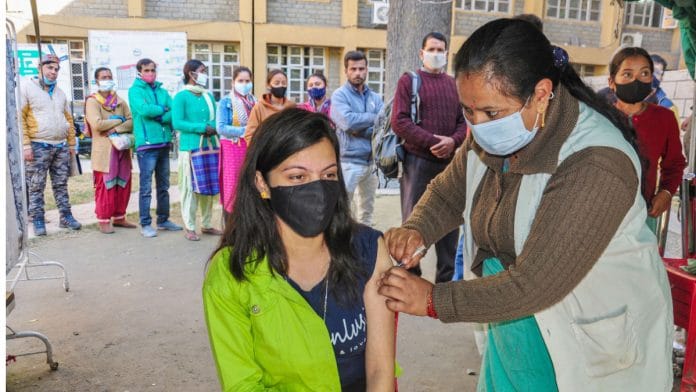New Delhi: As Covid cases surge in several countries, Union Health Secretary Rajesh Bhushan Wednesday wrote to 13 states and union territories, expressing concern over the declining weekly testing rate and a spike in positivity rate in some districts.
Bhushan wrote separate letters written to Nagaland, Sikkim, Maharashtra, Kerala, Goa, Manipur, Meghalaya, Mizoram, Jammu and Kashmir, Punjab, Rajasthan, West Bengal, and Ladakh, saying that due to the increase in travel because of marriages, festivals and vacations, it is important to maintain high testing rates.
“In the absence of sustained levels of sufficient testing, it is very difficult to determine the true level of infection spread in a geography. With a majority of countries seeing multiple surges in Covid cases in recent times, and a few developed countries facing even a fourth and fifth wave despite high levels of Covid vaccination, there is a need for continued vigil given the unpredictable and contagious nature of the disease,” Bhushan wrote.
“Hence, all efforts must be implemented to preserve the gains made so far and to prevent deterioration of Covid-19 scenario in the country,” he continued.
“Also, with the onset of winter and increased pollution in some states, prevalence of ILI (influenza-like illnesses)/SARI (severe acute respiratory infections) and respiratory distress symptoms should be closely monitored, with tests being conducted regularly for timely monitoring and clustering of cases for early hotspot identification,” the IAS officer added.
Also read: ‘Cut Covishield gap, skies won’t fall’, says Covid task force member as vaccines pile up
Low tests per million, high positivity rate
In his letter, Bhushan mentioned testing details and positivity rates of states and districts.
Rajasthan reported 14,168 average daily tests during the last week. This, Bhushan noted, was in stark contrast to the 84,266 average daily tests being conducted in the week of 12-18 July.
Bhushan went on to note that several districts in Rajasthan, including Barmer, Bharatpur, Dholpur and Sri Ganganagar, among others, have “unacceptably low tests per million” in the week of 15-21 November. The share of the RT-PCR tests conducted has fallen below a decent proportion of the total tests, the letter stated.
For example, in the district of Pali, only 12.09 per cent of the total tests conducted were RT-PCR tests, while the rest were rapid antigen tests.
Meanwhile, in Maharashtra, Bhushan noted that testing had gone down from over 2.68 lakh daily average during 17-23 May, to about 9,502 last week. Several districts, including Amravati, Buldhana, Dhule, Gonda, Hingoli, Nandurbar, Washim and Yavatmal, are conducting average tests per million below the WHO recommended number of 140, which is a cause for concern.
Kerala, Bhushan said, was conducting over 2.9 lakh average daily tests in the week of 9-15 August. This has reduced to 56,071 in the week ending 22 November.
The state is also showing a high positivity of 9.7 per cent, Bhushan pointed out. The test positivity rate in the districts of Wayanad, Kozhikode, Thiruvananthapuram, Idukki, Kollam and Kannur has been above 10 per cent, along with the fact that there has been a drop in testing.
In the district of Kannur, the positivity has increased by over 22 per cent over the last four weeks. Wayanad currently has a high positivity of 13.72 per cent.
The union territory of Jammu and Kashmir — where average daily tests have fallen from over 1,00,000 in the week of 16-22 August to 46,647 last week — also has a very low share of RT-PCR tests. Only 15.2 per cent of the total tests being conducted in the state are RT-PCR.
West Bengal’s Jalpaiguri district saw a 35 per cent rise in its test positivity over the last four weeks, although its test positivity is at 2.59 per cent.
For Ladakh, Bhushan said it was worrying to note that the UT’s test positivity increased from 3.14 per cent in the week ending 15 November to 4.4 per cent in the week ending 21 November. This is accompanied by a decline in testing, with just 475 average daily tests conducted in the last week. About 1,435 daily tests were being conducted in the state in the week of 3-9 May, in the midst of India’s second wave.
In Meghalaya’s East Garo Hills, the test positivity rose by over 92 per cent over the last two weeks. The state is conducting 2,279 average daily tests as of 22 November, as opposed to 6,792 tests being conducted in the week of 19-25 July.
“Nagaland has reported 342 average daily tests as of the week ending 22 November. This is in a stark contrast to a high of 1,250 average daily tests conducted in the week of 23 to 29 August. It is also worrying to note that the state has recorded a positivity of 1.5 per cent in the week ending 22 November, having stagnated over the past four weeks, with an abysmally low share of RT-PCR tests, i.e., 8.2 per cent,” Bhushan wrote.
(Edited by Neha Mahajan)
Also read: India’s R value for Covid drops to 0.94, but Chennai, Pune see rise in infection rate






